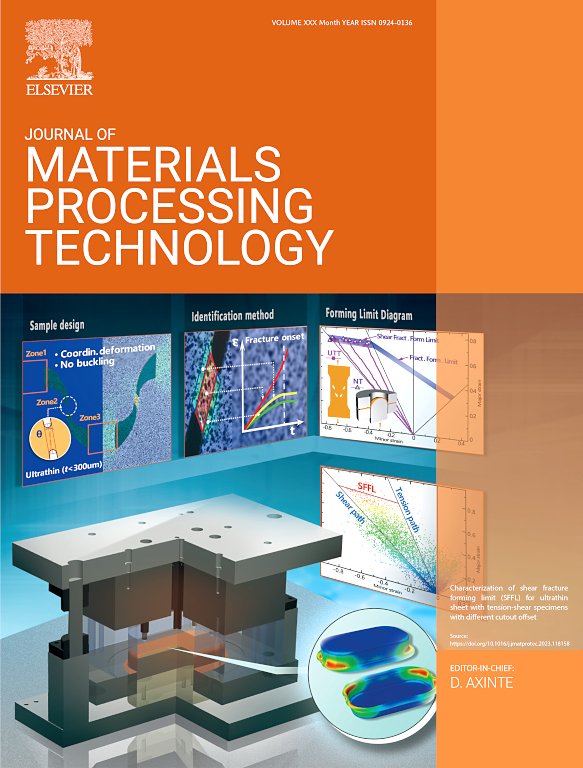Collaborative improvement of macro-deformation and fatigue property for thin-walled parts in TA19 titanium alloy via a double-sided simultaneous ultrasonic surface rolling process
IF 6.7
2区 材料科学
Q1 ENGINEERING, INDUSTRIAL
Journal of Materials Processing Technology
Pub Date : 2024-10-10
DOI:10.1016/j.jmatprotec.2024.118616
引用次数: 0
Abstract
To obtain thin-walled parts with superior geometric accuracy and fatigue resistance, a novel material surface processing paradigm, double-side simultaneous ultrasonic surface rolling process (DS-USRP), was proposed. The effects of the proposed process on the deformation suppression, surface modification, and fatigue improvement in thin-walled parts of the TA19 titanium alloy were also evaluated in this work. The average geometric deformation of thin-walled parts with the DS-USRP can decrease by ∼30 %. The fatigue life of thin-walled parts at elevated temperatures increased by a maximum of 60.9 times, and the corresponding fatigue strength was increased by 15.43 %. The surface integrity and microstructure of thin-walled parts also significantly change, and there is no failure risk associated with the superimposed effects of bilateral reinforcement. This study demonstrated that the synchronization of the compressive residual stress field evolution on both sides and the temporary increase in static stiffness could suppress the macro-deformation of the thin-walled parts during material surface processing. The improvement in fatigue-resistance at high temperatures is attributed to the low geometrical notch stress concentration and high compressive residual stress field. A moderate rolling intensity is essential to maximize the combined effect of the excellent surface quality and compressive residual stress field. Therefore, the proposed DS-USRP pattern is a promising and effective technique for the high-performance manufacturing of thin-walled parts in titanium alloys.
通过双面同步超声波表面轧制工艺协同改善 TA19 钛合金薄壁零件的宏观变形和疲劳性能
为了获得具有优异几何精度和抗疲劳性能的薄壁零件,提出了一种新型材料表面加工范例--双面同步超声波表面滚压工艺(DS-USRP)。这项工作还评估了所提出的工艺对 TA19 钛合金薄壁零件的变形抑制、表面改性和疲劳改善的影响。使用 DS-USRP 的薄壁零件的平均几何变形量可减少 ∼ 30%。薄壁零件在高温下的疲劳寿命最大提高了 60.9 倍,相应的疲劳强度提高了 15.43%。薄壁零件的表面完整性和微观结构也发生了显著变化,并且不存在与双边加固的叠加效应相关的失效风险。这项研究表明,两侧压缩残余应力场的同步演变和静态刚度的暂时增加可以抑制材料表面加工过程中薄壁零件的宏观变形。高温下抗疲劳性能的改善归功于低几何缺口应力集中和高压缩残余应力场。适度的轧制强度对于最大限度地发挥优良的表面质量和压缩残余应力场的综合效应至关重要。因此,所提出的 DS-USRP 模式是制造高性能钛合金薄壁零件的一种有前途的有效技术。
本文章由计算机程序翻译,如有差异,请以英文原文为准。
求助全文
约1分钟内获得全文
求助全文
来源期刊

Journal of Materials Processing Technology
工程技术-材料科学:综合
CiteScore
12.60
自引率
4.80%
发文量
403
审稿时长
29 days
期刊介绍:
The Journal of Materials Processing Technology covers the processing techniques used in manufacturing components from metals and other materials. The journal aims to publish full research papers of original, significant and rigorous work and so to contribute to increased production efficiency and improved component performance.
Areas of interest to the journal include:
• Casting, forming and machining
• Additive processing and joining technologies
• The evolution of material properties under the specific conditions met in manufacturing processes
• Surface engineering when it relates specifically to a manufacturing process
• Design and behavior of equipment and tools.
 求助内容:
求助内容: 应助结果提醒方式:
应助结果提醒方式:


